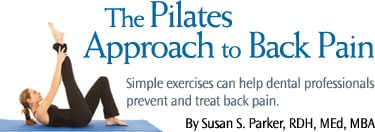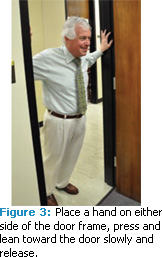
The Pilates Approach to Back Pain
Simple exercises can help dental professionals prevent and treat back pain.
 From New Orleans quarterback, Drew Brees, whose strength and conditioning enabled him to play so effectively in Super Bowl XLIV to American Olympic skier Lindsay Vonn who won the gold despite a painful shin injury, the body can achieve amazing feats when it is in prime shape. Pilates is a series of nonimpact exercises designed to develop strength, flexibility, balance, and inner awareness. All core muscles contribute to the optimal lumbar-pelvic stabilization needed for athletic performance as well as for the healthful completion of everyday tasks.1
From New Orleans quarterback, Drew Brees, whose strength and conditioning enabled him to play so effectively in Super Bowl XLIV to American Olympic skier Lindsay Vonn who won the gold despite a painful shin injury, the body can achieve amazing feats when it is in prime shape. Pilates is a series of nonimpact exercises designed to develop strength, flexibility, balance, and inner awareness. All core muscles contribute to the optimal lumbar-pelvic stabilization needed for athletic performance as well as for the healthful completion of everyday tasks.1
ADDRESSING BACK PAIN
Dental professionals are predisposed to lower back pain because of the often overstrained and awkward back postures required. In an analysis conducted by the Ontario Dental Hygienists’ Association, 25% of dental hygienists with low back pain modify their work at some point while 45% of dental hygienists with low back pain have sought medical care due to work-related pain.2
Back pain is usually a composite of pain sent from points both above and below where the discomfort is felt. A key to successfully treating back pain is to track the components of the pain. The fact that there are many different muscles associated with the spine can make this difficult. To simplify the process, picture the muscles as the outer and inner layers of the spine. The outer layers are the superficial spinal muscles or long muscles running parallel to the spine. The inner layers are the deep spinal muscles that are very short and originate diagonally to the spine. This angular arrangement gives them good leverage for twisting and side-bending the spine. Working together, these muscles help extend the spine.3
Pilates exercise is designed to address the underlying structural imbalances in the body that lead to back pain. Problems such as lack of core support, pelvic instability, muscular imbalances, poor posture, and lack of body awareness all affect back health. The Pilates method specializes in improving these issues. For the spine, neutral posture is described as the ears, shoulders, and hip joints being aligned in a straight line, a slight forward curve in the lower back and cervical spine (neck), and a slight rearward curve in the upper back. Ideal alignment is a balanced posture in which positioning is centered and relaxed for all the joints of the body, muscles relaxed, and unnecessary tension released. When doing the following exercises, be sure to always keep the back full length and pressed firmly against the mat or the floor.
EXERCISES
Two simple but effective Pilates exercises can help those with and without back problems when performed correctly and consistently. Single leg stretch or “the one leg stretch” and the “rolling back” or rolling like a ball are very safe and effective exercises to practice. To execute the one leg stretch, lie supine with back anchored to the mat, extend one leg out above the floor and the other leg bent into the chest. The chin should be tilted forward resting in the notch of the manubrium (the upper segment of the sternum). Meanwhile place the fingers of one hand on the outside of the ankle of the leg that is extended and place the fingers of the inside hand lightly touching the inside of the knee of the same leg (Figure 1). Exhale for 2 counts and inhale for 2 counts changing legs repeating this set eight to 10 times. Focus on stretching the shin of the extended leg and maintaining an anchored spine to the mat when performing this exercise. Make sure to expel the air as much as possible.
Rolling like a ball relaxes the spine while the scooping of the abdominals strengthens the core. Breathing is what helps keep the momentum going in this fun movement. On the exhalation and with the chin forward resting on the notch of the manubrium, roll forward and then inhale and let the spine roll back (Figure 2). After several repetitions let the body relax and lower the legs onto the mat. Release or press out the lower pelvis into the mat.
As with any exercise there is also a counter stretch to the exercise for balancing the body. Dental professionals should open the front of the chest often with this stretch. This can be a traditional unfolding of the back with a back bend or opening the chest with an exercise that uses the frame of a door. For the latter, place a hand on either side of the door frame, press and lean toward the door slowly and release (Figure 3). Repeat this exercise a few times and perform several times during the day.
Through the strengthening and relaxation provided by Pilates, dental professionals can continue their work in patient care with painfree bodies and calm minds and spirits.
REFERENCES
- Alexopoulos E. Prevalence of Musculoskeletal Disorders in Dentists. Athens, Greece: BMC Musculoskeletal Disorders; 2004.
- Murphy DC. Ergonomics and the Dental Care Worker. 1st ed. Washington, DC: American Public Health Association; 1998.
- Davies C. The Trigger Point Therapy Workbook. 2nd ed. Oakland, Calif: New Harbinger Publications; 2004.
From Dimensions of Dental Hygiene. April 2010; 8(4): 52-53.


